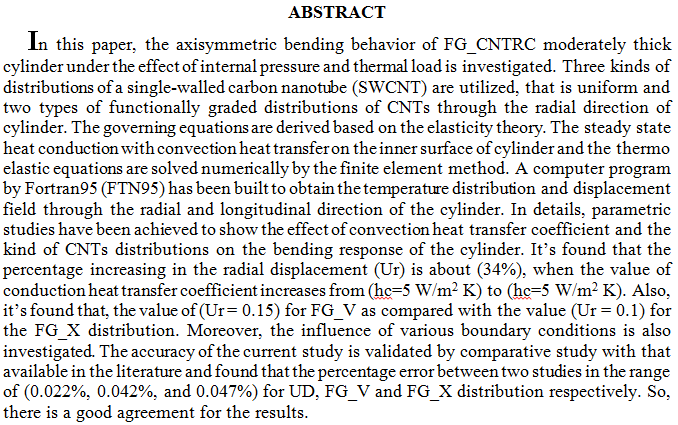
The main objective of this paper is to develop and validate flow injection method, a precise, accurate, simple, economic, low cost and specific turbidimetric method for the quantitative determination of mebeverine hydrochloride (MbH) in pharmaceutical preparations. A homemade NAG Dual & Solo (0-180º) analyser which contains two identical detections units (cell 1 and 2) was applied for turbidity measurements. The developed method was optimized for different chemical and physical parameters such as perception reagent concentrations, aqueous salts solutions, flow rate, the intensity of the sources light, sample volume, mixing coil and purge time. The correlation coefficients (r) of the developed method were 0.9980 and 0.9986 for cell
... Show More (28)
(28)
 (11)
(11)
 (1)
(1)
 (1)
(1)
The aim of the research is to identify the effectiveness of the educational pillars strategy based on Vygotsky's theory in mathematical achievement and information processing of first-grade intermediate students. In pursuit of the research objectives, the experimental method was used, and the quasi-experimental design was used for two equivalent groups, one control group taught traditionally and the other experi-mental taught according to the educational pillars strategy. The research sample consisted of (66) female students from the first intermediate grade, who were inten-tionally chosen after ensuring their equivalence, taking into account several factors, most notably chronological age and their level of mathematics, and they we
... Show More (2)
(2)
Background: The microhardness of a composite resin is a vital parameter that is used to determine its clinical behavior. Measuring the microhardness of a composite resin has been used as an indirect method to assess its degree of conversion and extent of polymerization. The purpose of this in vitro study was to evaluate the effect of three curing distances (0, 2, and 4 mm) on the microhardness of the top and bottom surfaces of three types of flowable bulk-fill composite resins (smart dentin replacement, Opus bulk fill flow, and Tetric N). Material and method: Sixty-three specimens from the three types of composite resins (n=21) were fabricated using Teflon mold with a 4mm depth and a 5 mm internal diameter and cured for 20 seconds. For e
... Show More (2)
(2)
 (1)
(1)
In this work polymeric composites were done from unsaturated polyester as a matrix reinforced with glass fiber type (E-glass) with two different volume fraction 20% & 40%. Fatigue tests showed that the number of fatigue cycles to failure limit for samples reinforced with uniform (woven Roving 0-90°) E-glass fiber and random (continuous fibers) with volume fraction 40% more than that for the same samples with volume fraction 20%. Also the fatigue results showed that the uniform samples failed with fatigue cycles more than that of random.
- The sandy soil with high gypsum content (usually referred to as gypseous soil) covers vast area in south, east, middle and west regions of Iraq, such soil possess a type of cohesive forces when attached with optimum amount of water, then compacted and allowed to cure, but losses its strength when flooded with water again. Much work on earth reinforcement was published which concentrate on the gain in bearing capacity in the reinforced layer using different types of cohesive or cohesion less soil and various types of reinforcement such as plastic, metal, grids, and synthetic textile. Little attention was paid to there enforce gypseous soil. The objective of this work is to study the interaction between such soil and reinforcement strips
... Show More (1)
(1)
The adopted accelerated curing methods in the experimental work are 55ºC and 82ºC according to British standard methods. The concrete mix with the characteristics compressive strength of 35MPa is design according to the ACI 211.1, the mix proportion is (1:2.65:3.82) for cement, fine and coarse aggregate, respectively. The concrete reinforced with different volume fraction (0.25, 0.5 and 0.75)% of glass, carbon and polypropylene fibers. The experimental results showed that the accelerated curing method using 82ºC gives a compressive strength higher than 55ºC method for all concrete mixes. In addition, the fiber reinforced concrete with 0.75% gives the maximum compressive strength, flexural and splitting tensile strength for all types of
... Show MoreImproving the accuracy of load-deformation behavior, failure mode, and ultimate load capacity for reinforced concrete members subjected to in-plane loadings such as corbels, wall to foundation connections and panels need shear strength behavior to be included. Shear design in reinforced concrete structures depends on crack width, crack slippage and roughness of the surface of cracks.
This paper illustrates results of an experimental investigation conducted to investigate the direct shear strength of fiber normal strength concrete (NSC) and reactive powder concrete (RPC). The tests were performed along a pre-selected shear plane in concrete members named push-off specimens. The effectiveness of concrete compressiv
... Show MoreGlass Fiber Reinforced Polymer (GFRP) bars have gained popularity as a corrosion-resistant alternative to traditional steel reinforcement in Reinforced Concrete (RC) elements. This study investigates the flexural behavior of PRC panels reinforced with GFRP bars. The study variables included the GFRP reinforcement ratio and the number of embedded steel section distributions. Six concrete panels were fabricated, each measuring 2500 mm in length, with a rectangular cross-section of 750 mm in width and 150 mm in thickness. All panels were reinforced with GFRP bars and divided into two groups based on the reinforcement ratios of 0.532% and 0.266%. For each group, one panel served as the control specimen, while the remaining two were inte
... Show More